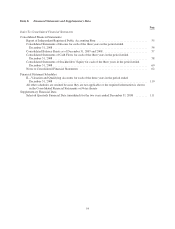Yahoo 2008 Annual Report Download - page 58
Download and view the complete annual report
Please find page 58 of the 2008 Yahoo annual report below. You can navigate through the pages in the report by either clicking on the pages listed below, or by using the keyword search tool below to find specific information within the annual report.rate, which will result in an increase to the expense recognized in the consolidated financial statements. See
Note 12—“Employee Benefits” in the Notes to the consolidated financial statements for additional information.
Recent Accounting Pronouncements. See Note 1—“The Company and Summary of Significant Accounting
Policies” in the Notes to the consolidated financial statements.
Item 7A. Quantitative and Qualitative Disclosures About Market Risk
We are exposed to the impact of interest rate changes, foreign currency exchange rate fluctuations, and changes
in the market values of our investments.
Interest Rate Risk. Our exposure to market rate risk for changes in interest rates relates primarily to our
investment portfolio. We invest excess cash in money market funds and liquid marketable debt instruments of the
U.S. Government and its agencies, state municipalities, and in high-quality corporate issuers.
Investments in both fixed rate and floating rate interest earning instruments carry a degree of interest rate risk.
Fixed rate securities may have their fair market value adversely impacted due to a rise in interest rates, while
floating rate securities may produce less income than expected if interest rates fall. Due in part to these factors,
our future investment income may fall short of expectations due to changes in interest rates or we may suffer
losses in principal if forced to sell securities which have declined in market value due to changes in interest rates.
As of December 31, 2008 and 2007, we had investments in short-term marketable debt securities of
approximately $1.2 billion and $488 million, respectively. Such investments had a weighted-average yield of
approximately 1.2 percent and 4.5 percent, respectively. As of December 31, 2008 and 2007, we had investments
in long-term marketable debt securities of approximately $70 million and $362 million, respectively. Such
investments had a weighted average yield of approximately 4.0 percent and 5.0 percent, respectively.
A hypothetical 100 basis point increase in interest rates would result in an approximate $2 million and $4 million
decrease (approximately 1 percent), respectively, in the fair value of our available-for-sale debt securities as of
December 31, 2008 and 2007.
Foreign Currency Risk. International revenues accounted for approximately 28 percent of total revenues during
2008 and 32 percent of total revenues during both 2007 and 2006, respectively. International revenues in 2008
decreased $224 million, or 10 percent, as compared to 2007. Revenues and related expenses generated from our
international subsidiaries are generally denominated in the currencies of the local countries. Primary currencies
include Australian Dollars, British Pounds, Euros, Korean Won, and Taiwan Dollars. The statements of income
of our international operations are translated into U.S. dollars at exchange rates indicative of market rates during
each applicable period. To the extent the U.S. dollar strengthens against foreign currencies, the translation of
these foreign currency-denominated transactions results in reduced revenues, operating expenses, and net income
for our International segment. Similarly, our revenues, operating expenses, and net income will increase for our
International segment if the U.S. dollar weakens against foreign currencies. Using the foreign currency exchange
rates from 2007, our international revenues for 2008 would have been higher than we reported by approximately
$32 million and our International segment operating loss before depreciation, amortization, and stock-based
compensation expense would have been higher than we reported by $120 million (which includes $96 million
related to the goodwill impairment).
We are also exposed to foreign exchange rate fluctuations as we convert the financial statements of our foreign
subsidiaries and our investments in equity interests into U.S. dollars in consolidation. If there is a change in foreign
currency exchange rates, the conversion of the foreign subsidiaries’ financial statements into U.S. dollars results in a
gain or loss which is recorded as a component of accumulated other comprehensive income which is part of
stockholders’ equity. In addition, we have certain assets and liabilities that are denominated in currencies other than
the respective entity’s functional currency. Changes in the functional currency value of these assets and liabilities
create fluctuations that will lead to a gain or loss. We recorded foreign currency transaction gains and losses,
realized and unrealized, in other income, net on the consolidated statements of income, of approximately $25
million of net losses in 2008 and net gains of $7 million and $5 million in 2007 and 2006, respectively.
52
























